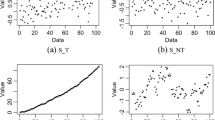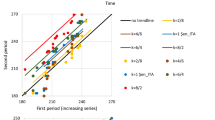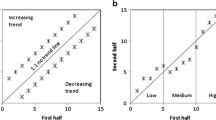Abstract
Recently, climate change makes itself felt at increasing levels due to rising temperatures, irregular precipitation patterns, and changing weather events. Although the frequently used Mann–Kendall (MK) method has disadvantages such as needing serial independence, it helps to detect monotonic trends to investigate climate change effects on a given time series. Climate change may have different features on different levels such as the lows and highs of a given time series, leading to non-monotonic trends. Innovative trend analysis (ITA) as an innovative trend analysis method detects non-monotonic trends, which MK cannot. In this study, MK method is improved to detect non-monotonic trends (non-monotonic MK) and applied for Murat River basin, a branch of Euphrates River, precipitation series at Bingöl, Muş, and Ağrı meteorological stations. Although classical MK method cannot detect any trend on the river basin, non-monotonic MK (NMK) method detects two important decreasing (an increasing) trends on the low (high) values of Bingöl and Muş (Bingöl) stations. Also, stationarity analysis is applied through the statistical significance level concept for the river basin precipitation series using the NMK method. Bingöl station has a non-stationary precipitation series with a \({z}_{NMK}\) value of 3.07 and 95% confidence level, while Muş station has a remarkable \({z}_{NMK}\) value of 1.58, Ağrı station conserves its stationarity characteristic on the precipitation series. It is hoped that the newly developed NMK method will help to understand the effects of climate change on hydro-meteorological historical records and predict future events for more efficient hydraulic structure designs.





Similar content being viewed by others
References
Alashan S (2020) Combination of modified Mann-Kendall method and Şen innovative trend analysis. Eng Rep n/a:e12131. https://doi.org/10.1002/eng2.12131
Alashan S (2018) Data analysis in nonstationary state. Water Resour Manag https://doi.org/10.1007/s11269-018-1928-2
Alashan S, Şen Z, Toprak ZF (2016) Hydroelectric energy potential of Turkey: a refined calculation method. Arab J Sci Eng 41. https://doi.org/10.1007/s13369-015-1982-5
Alifujiang Y, Abuduwaili J, Ge Y (2021) Trend analysis of annual and seasonal river runoff by using innovative trend analysis with significant test. Water (Switzerland). https://doi.org/10.3390/w13010095
Bayazit M (2015). Nonstationarity of hydrological records and recent trends in trend analysis: a state-of-the-art review. Environ Process. https://doi.org/10.1007/s40710-015-0081-7
Bayazit M, Önöz B (2007) To prewhiten or not to prewhiten in trend analysis? Hydrol Sci J. https://doi.org/10.1623/hysj.52.4.611
Berhail S, Tourki M, Merrouche I, Bendekiche H (2022) Geo-statistical assessment of meteorological drought in the context of climate change: case of the Macta basin (Northwest of Algeria). Model Earth Syst Environ https://doi.org/10.1007/s40808-020-01055-7
Burić D, Doderović M (2021) Changes in temperature and precipitation in the instrumental period (1951–2018) and projections up to 2100 in Podgorica (Montenegro). Int J Climatol 41:E133–E149. https://doi.org/10.1002/joc.6671
Cox DR, Stuart A (1955) Some quick sign tests for trend in location and dispersion. Biometrika. https://doi.org/10.2307/2333424
Cramér H (1936) Über eine Eigenschaft der normalen Verteilungsfunktion. Math Zeitschrift. https://doi.org/10.1007/BF01180430
Dabanli I, Şişman E, Güçlü YS, Birpınar ME, Şen Z (2021) Climate change impacts on sea surface temperature (SST) trend around Turkey seashores. Acta Geophys. https://doi.org/10.1007/s11600-021-00544-2
Faulkner D, Warren S, Spencer P, Sharkey P (2020) Can we still predict the future from the past? Implementing non-stationary flood frequency analysis in the UK. J Flood Risk Manag 13. https://doi.org/10.1111/jfr3.12582
Günek H (2006) Murat Nehri Havzasının (Fırat) Su Potansiyeli ve Değerlendirilmesi. Doğu Coğrafya Dergisi 11(16):141–163
Haan CT (1977) Statistical methods in hydrology. Stat Methods Hydrol. https://doi.org/10.1201/9780429423116-36
Hamed KH (2009) Exact distribution of the Mann-Kendall trend test statistic for persistent data. J Hydrol. https://doi.org/10.1016/j.jhydrol.2008.11.024
Hamed KH, Ramachandra Rao A (1998) A modified Mann-Kendall trend test for autocorrelated data. J Hydrol 204:182–196. https://doi.org/10.1016/S0022-1694(97)00125-X
Harris I, Osborn TJ, Jones P, Lister D (2020) Version 4 of the CRU TS monthly high-resolution gridded multivariate climate dataset. Sci Data 7. https://doi.org/10.1038/s41597-020-0453-3
Katipoglu OM, Acar R, Şenocak S (2021) Spatio-temporal analysis of meteorological and hydrological droughts in the Euphrates Basin, Turkey. Water Sci Technol Water Supply 21:1657–1673. https://doi.org/10.2166/WS.2021.019
Kendall MG (1975) Rank correlation methods. Charless Griffin, London
Kendall MG, Gibbons JD (1990) Rank correlation methods, 5th edn. Griffin, London
Khaliq MN, Ouarda TBMJ, Ondo JC, Gachon P, Bobée B (2006) Frequency analysis of a sequence of dependent and/or non-stationary hydro-meteorological observations: a review. J Hydrol. https://doi.org/10.1016/j.jhydrol.2006.03.004
Lins HF, Cohn TA (2011) Stationarity: wanted dead or alive? J Am Water Resour Assoc. https://doi.org/10.1111/j.1752-1688.2011.00542.x
Mann HB (1945) Nonparametric tests against trend. Econometrica 13:245. https://doi.org/10.2307/1907187
Matalas NC (2012) Comment on the announced death of stationarity. J Water Resour Plan Manag. https://doi.org/10.1061/(asce)wr.1943-5452.0000215
Milly PCD, Bentacourt J, Falkenmark M, Robert M, Hirsch RM, Kundzewicz ZW, Letternmaier DP, Stouffer RJ (2008) Stationarity is dead: whither water management? Science 319:573–574. https://doi.org/10.1126/science.1151915
Montanari A, Koutsoyiannis D (2014) Modeling and mitigating natural hazards: stationarity is immortal! Water Resour Res. https://doi.org/10.1002/2014WR016092
Nigussie TA, Altunkaynak A (2019) Impacts of climate change on the trends of extreme rainfall indices and values of maximum precipitation at Olimpiyat Station, Istanbul, Turkey. Theor Appl Climatol 135:1501–1515. https://doi.org/10.1007/s00704-018-2449-x
Oruc S (2021) Trend and nonstationary relation of extreme rainfall: Central Anatolia, Turkey. Acta Geophys https://doi.org/10.1007/s11600-020-00518-w
Saplıoğlu K, Güçlü YS (2022) Combination of Wilcoxon test and scatter diagram for trend analysis of hydrological data. J Hydrol 612:128132. https://doi.org/10.1016/j.jhydrol.2022.128132
Sen PK (1968) Estimates of the regression coefficient based on Kendall’s tau. J Am Stat Assoc 63:1379–1389. https://doi.org/10.1080/01621459.1968.10480934
Serinaldi F, Kilsby CG (2015) Stationarity is undead: uncertainty dominates the distribution of extremes. Adv Water Resour. https://doi.org/10.1016/j.advwatres.2014.12.013
Serinaldi F, Kilsby CG, Lombardo F (2018) Untenable nonstationarity: an assessment of the fitness for purpose of trend tests in hydrology. Adv Water Resour. https://doi.org/10.1016/j.advwatres.2017.10.015
Sezen C, Partal T (2020) Wavelet combined innovative trend analysis for precipitation data in the Euphrates-Tigris basin, Turkey. Hydrol Sci J 1909–1927. https://doi.org/10.1080/02626667.2020.1784422
Solaimani K (2022) Seasonal relationship between climatic variables and evaporation based on Bayesian quantile regression method in southern Caspian region. Arab J Geosci 15:1000. https://doi.org/10.1007/s12517-022-10263-7
Spearman C (1987) The proof and measurement of association between two things. By C. Spearman, 1904. Am J Psychol 100:441–471. https://doi.org/10.2307/1422689
Şan M, Akçay F, Linh NTT, Kankal M, Pham QB (2021) Innovative and polygonal trend analyses applications for rainfall data in Vietnam. Theor Appl Climatol 144:809–822. https://doi.org/10.1007/s00704-021-03574-4
Şen Z (2012) Innovative trend analysis methodology. J Hydrol Eng 17:1042–1046. https://doi.org/10.1061/(ASCE)HE.1943-5584.0000556
Şişman E, Kizilöz B (2021) The application of piecewise ITA method in Oxford, 1870–2019. Theor Appl Climatol 145:1451–1465. https://doi.org/10.1007/s00704-021-03703-z
Vogel RM, Yaindl C, Walter M (2011) Nonstationarity: flood magnification and recurrence reduction factors in the United States. J Am Water Resour Assoc. https://doi.org/10.1111/j.1752-1688.2011.00541.x
Yürekli K (2015) Impact of climate variability on precipitation in the Upper Euphrates-Tigris Rivers Basin of Southeast Turkey. Atmos Res 154:25–38. https://doi.org/10.1016/j.atmosres.2014.11.002
Acknowledgements
The author thanks the World Bank Group and the University of East Anglia Climate Research Unit (CRU) for the data provided. The author thanks the Editor and the anonymous reviewers for their contributions to the content and development of this paper.
Author information
Authors and Affiliations
Contributions
There is only an author.
Corresponding author
Ethics declarations
Ethics approval
The submitted work is original and has not been published elsewhere in any form or language.
Consent to participate
Not applicable.
Consent for publication
Not applicable.
Competing interests
The authors declare no competing interests.
Additional information
Publisher's Note
Springer Nature remains neutral with regard to jurisdictional claims in published maps and institutional affiliations.
Rights and permissions
Springer Nature or its licensor (e.g. a society or other partner) holds exclusive rights to this article under a publishing agreement with the author(s) or other rightsholder(s); author self-archiving of the accepted manuscript version of this article is solely governed by the terms of such publishing agreement and applicable law.
About this article
Cite this article
Alashan, S. Non-monotonic trend analysis using Mann–Kendall with self-quantiles. Theor Appl Climatol 155, 901–910 (2024). https://doi.org/10.1007/s00704-023-04666-z
Received:
Accepted:
Published:
Issue Date:
DOI: https://doi.org/10.1007/s00704-023-04666-z




